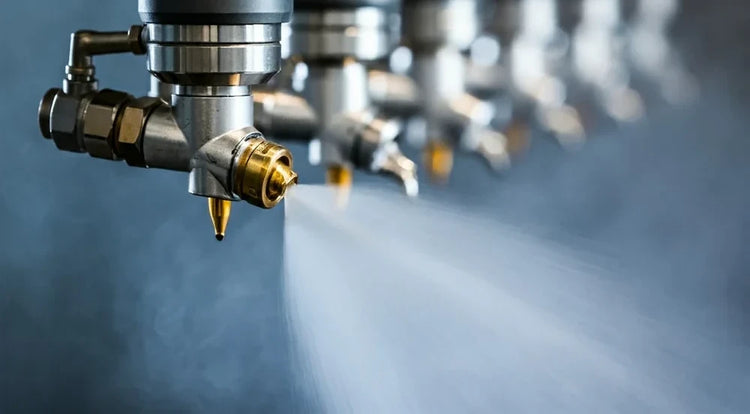Descaling Spray Nozzles for Steel & Metal Mills
High-impact oxide removal at 150–250 bar for hot rolling mills, plate mills, and bar mills—achieve 99%+ scale removal, extend roll life 40–60%, and eliminate surface defects with engineered descaling headers.
Mill scale and primary oxides formed during reheating and hot rolling create persistent quality and productivity challenges in steel production. Scale layers ranging from 20–500 µm thickness cause surface defects (scale pits, slivers, rolled-in scale), increase rolling forces 15–30%, accelerate roll wear, prevent proper roll bite, and compromise dimensional accuracy. Incomplete scale removal results in surface rejection, costly grinding and scarfing operations, customer complaints, and downtime for emergency roll changes.
NozzlePro engineers high-pressure descaling systems combining optimized nozzle geometry, precision header design, and hydraulically efficient manifolds to deliver the kinetic energy required for complete oxide layer removal. Our descaling headers operate at 150–250 bar (2,200–3,600 PSI), generating 20–50 N/cm² impact forces that fracture and dislodge primary scale, secondary scale, and tertiary oxides before hot rolling—enabling defect-free surfaces, reduced roll wear, lower energy consumption, and improved dimensional control across structural steel, plate, bar, and long product mills processing 50–2,000 tons per hour.
Critical Descaling Applications in Steel Production
🔥 Primary Descaling (Reheat Furnace Discharge)
High-impact headers positioned immediately after reheat furnace discharge remove thick primary scale (100–500 µm) formed during slab/billet/bloom reheating at 1,200–1,300°C. Multi-bank systems deliver 150–250 bar impact forces from top, bottom, and side positions ensuring complete scale fracture and removal before roughing mill entry—preventing scale embedding and downstream defects.
Primary Descaling Systems →⚙️ Inter-Stand Descaling (Hot Strip Mills)
Compact descaling headers between roughing stands remove secondary scale formation, prevent scale roll-in during subsequent passes, and maintain clean metal surfaces for optimal friction control. Rapid-response systems activate based on strip presence, delivering targeted scale removal without excessive water application that affects mill temperature control.
Inter-Stand Headers →📏 Finishing Mill Entry Descaling
High-efficiency descaling immediately before finishing train removes any remaining tertiary oxides, scale residue, and surface contamination. Complete descaling at this stage prevents roll scratching, enables tighter gauge control, improves surface finish quality, and eliminates the primary cause of coil downgrading and customer quality complaints.
Finishing Mill Systems →🏗️ Plate Mill Descaling
Heavy-duty descaling headers for plate mills handling 8–300mm thick products at 800–1,200°C. Multi-pass descaling systems accommodate varying plate widths (1,200–5,000mm) and provide sufficient dwell time for complete oxide removal on thick sections where scale adhesion is strongest—ensuring surface quality for pressure vessel, structural, and shipbuilding applications.
Plate Mill Descalers →📐 Bar & Section Mill Descaling
Specialized descaling systems for long products including rebar, angles, channels, beams, and rounds. Rotary descaling heads or multi-angle spray configurations provide complete circumferential coverage on round and complex cross-sections, removing scale from all surfaces including web-flange intersections where scale tends to accumulate.
Section Mill Descalers →🔧 Maintenance & Nozzle Optimization
Descaling header performance degrades over time due to nozzle wear, orifice erosion, and mineral deposits. Regular nozzle inspection, flow testing, and replacement programs maintain consistent impact forces, prevent uneven descaling patterns, and avoid quality issues from degraded spray performance. We provide wear-resistant nozzles, quick-change systems, and performance monitoring solutions.
Descaling Maintenance →Performance Benefits of Engineered Descaling Systems
- Complete Scale Removal – High-pressure systems achieve 99%+ scale removal efficiency, eliminating primary, secondary, and tertiary oxides before rolling operations begin.
- Surface Quality Improvement – Defect-free surfaces eliminate scale pits, slivers, rolled-in scale, and surface contamination—reducing rejection rates 60–80% and increasing prime yield.
- Extended Roll Life – Complete descaling reduces abrasive wear on work rolls by 40–60%, extending roll campaigns from 5,000 to 12,000+ tons and decreasing roll consumption costs.
- Reduced Rolling Forces – Scale removal lowers rolling forces 15–30%, decreasing motor loads, reducing energy consumption, and enabling faster line speeds without exceeding mill capacity.
- Improved Dimensional Control – Consistent descaling enables uniform friction conditions, tighter gauge tolerances (±0.02–0.05mm), improved flatness, and reduced camber throughout rolling schedules.
- Higher Production Rates – Reliable descaling eliminates unscheduled stops for scale-related quality issues, enables faster rolling speeds, and increases annual throughput 8–15%.
- Eliminated Secondary Operations – Complete descaling eliminates costly post-rolling grinding, scarfing, shot blasting, and pickling operations previously required to correct scale-related defects.
- Reduced Downtime – Fewer roll changes, decreased scale-related cobbles, and elimination of emergency stops for quality issues improve overall equipment effectiveness (OEE) 5–12%.
Engineering High-Performance Descaling Systems
Application-Specific Parameters
| Application | Pressure Range | Impact Force | Water Consumption | Shop Collection |
|---|---|---|---|---|
| Primary Descaling (Reheat Exit) | 200–250 bar | 35–50 N/cm² | 15–40 m³/hour per header | High-Pressure |
| Inter-Stand (Roughing Mill) | 150–200 bar | 25–40 N/cm² | 8–20 m³/hour per station | High-Pressure |
| Finishing Mill Entry | 180–220 bar | 30–45 N/cm² | 12–30 m³/hour per header | High-Pressure |
| Heavy Plate Mill | 200–250 bar | 40–55 N/cm² | 25–60 m³/hour per header | High-Pressure |
| Bar & Section Mills | 150–220 bar | 28–45 N/cm² | 10–25 m³/hour per header | Full Cone |
| Wire Rod Mill | 120–180 bar | 20–35 N/cm² | 5–15 m³/hour per station | Full Cone |
Custom Engineering: Final system specifications depend on steel grade (carbon content affects scale adhesion), product dimensions, line speed, scale thickness, reheating temperature, and mill configuration. Request a descaling analysis and we'll provide detailed header layouts, hydraulic calculations, impact force modeling, and ROI projections including surface quality improvement, roll life extension, and energy savings for your specific mill operation.
Understanding Mill Scale Formation & Removal
Primary Scale (Reheat Furnace)
Thick oxide layers (100–500 µm) form during slab reheating at 1,200–1,300°C. Multilayer structure: wüstite (FeO) adjacent to steel, magnetite (Fe₃O₄) middle layer, hematite (Fe₂O₃) outer layer. Strong adhesion requires 200–250 bar impact forces for complete removal. Failure to remove causes severe surface defects.
Secondary Scale (Inter-Stand)
Thin oxide layers (10–50 µm) form between roughing passes due to high-temperature steel exposure to atmosphere. Rapid formation (seconds) requires inter-stand descaling to prevent roll-in during subsequent passes. Lighter scale adhesion allows 150–200 bar descaling pressures.
Tertiary Scale (Finishing Entry)
Very thin oxides (5–20 µm) and scale residue remaining after primary/secondary descaling. Final descaling before finishing ensures completely clean surface for tight gauge control, improved surface finish, and defect-free product. Critical for automotive, appliance, and high-quality applications.
Hydraulic Scale Removal Mechanism
High-pressure water jets create shock waves that fracture brittle oxide layers, propagate cracks through scale-steel interface, and hydraulically lift broken scale from steel surface. Impact force (pressure × velocity) must exceed scale adhesion strength (varies 10–50 MPa by steel grade, temperature, and oxidation time).
Related Steel & Metal Solutions
🔥 Steel Cooling
💧 Lubrication
🎨 Coating

